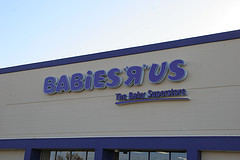Why Did My Free Gift Card Cost $10?

(Bob Reck)
He writes:
At the request of my wife, I went to Babies R Us in [redacted] on the afternoon of October 6th, 2013 expressly to take advantage of the Pampers diapers promotion they have offered: Buy two qualifying packs of Pampers and receive a free $10 gift card. I went about my shopping, picked up a few other things for our 14-month old and upon reaching the register, left scratching my head frustrated beyond belief.
When the cashier rang me up, I made sure to ask if I had purchased qualifying packs of Pampers, which I did. My total, with a few other items came to $105 and change. I was getting ready to pay, when the cashier reminds himself, “Oh, and let’s not forget your $10 gift card,” at which point he scanned a card and my total went up by exactly $10 to $115 and change.
I asked him why I was being charged $10 for a FREE $10 gift card and his only explanation was that “It’s confusing, but the money is on the card” and that they need to charge the $10 to activate the card. I maintained that I was actually then paying $10 for the free $10 card and was in effect receiving no promotional savings at all. His reply, “The $10 is on the card.” So why was I paying for it to go on the card if it was free? Circular discussion ensues.
After a few back and forths and his inability to explain where the phantom $10 disappeared to, I requested to speak to the manager on duty. The woman who came over was pleasant enough (the entire exchange in fact was never heated, just me somewhat incredulous and chuckling at the idea of contesting simple math), but again could do nothing other than state repeatedly that the “$10 is on the card.”
I again challenged that I was paying to receive a card of exactly that amount, to which she responded that she had no other way of explaining it to me and that “many customers take the card with no problem.” I suggested the promotion was confusing at least, deceptive at worst. Her reply was simply that if there was anything wrong with the promotion, “we’d have been sued by now” and to take it up with corporate.
I immediately requested to leave without any of the items in my cart and went to Target instead. Needless to say, I’ll be going directly to Target first in the future.
I very well may be missing something here, but if that’s the situation, I can’t seem to figure out which piece isn’t connecting for me. I’ll give them the benefit of the doubt and assume there is something that wasn’t explained well, but it that’s the case, this is a case of a very poorly trained staff holding up a corporate promotion without any ability to explain how it works. Where’s the FREE part coming in if I’m paying for it? This seems to be simple math to me, but maybe I’m just not seeing it? Am I crazy?
No, Mike, you’re not crazy–the employees just didn’t explain how the promotion works very well. From their point of view, it’s hard to explain transactions that you run every day to someone when they seem perfectly natural to you, isn’t it? As it turns out, the gift card really is free, but how the store gets there is kind of confusing. they mark down the items by $10, then “charge” you for the $10 gift card.
A Toys ‘R’ Us rep explained it to us like this:
In order to activate a promotional gift card such as the one in this offer, our point-of-sale system marks the qualifying item down by $10, and a $10 charge appears on the gift card line. Currently, this is the only way to activate the promotional gift card. The customer is not charged for this gift card, and had the transaction continued, this would have been reflected on his receipt.
So if he had to buy two items that originally cost $30 each to get the gift card, the receipt would show that they each rang up at $25, then add on a $10 gift card. You’re still spending the same amount in the end, but it creates the illusion that you’re somehow getting ripped off if you look at the transaction before the final total comes up.
Want more consumer news? Visit our parent organization, Consumer Reports, for the latest on scams, recalls, and other consumer issues.

